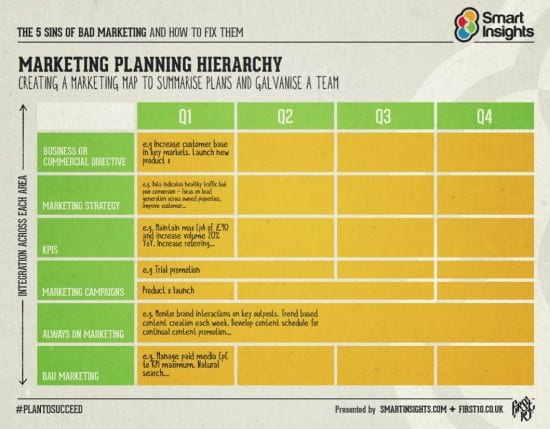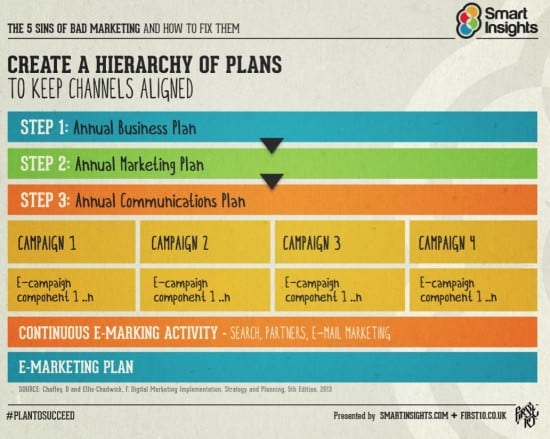A practical way to link different types of plan within a business
It’s often the blanket reactions to the word ‘planning’ that suggest somebody’s misunderstanding of what the word actually means. The classics are
- “I don’t have time to plan”? This is interesting since the same person has time to do the work again, or write off budget, for marketing that fails
- “I’m spending this week / month planning”. Wow - for what, the over keenness to get lost in planning can feel a bit too excitable sometimes!
- “I’m just getting on with it”. It’s common to see people deep dive into their work with lists, Gantt’s and schedules, and little context for the mass of action
So what’s the solution?
All planning is not the same, the purpose of planning is to enable enough forethought around the desired results vs costs from a set of actions. So it’s a ‘horses for courses’ thing and the key word is ‘enough’. We refer to it a hierarchy of planning, and it matters so much that we feature it in our recent #plantosucceed Slideshare.

The graphic above seeks to separate out the hierarchy of plans, if offers a helicopter view on the planning process, a framework even. It’s been specific about what you are seeking to achieve with the planning, starting from the bottom might be more useful:
- ‘BAU marketing’ (BAU: Business As Usual) is what so many digital marketers appear to focus on, it’s the tactics and channels, the day-to-day stuff. Tactical planning is useful, and extremely necessary to manage spend, change focus areas, to test and improve. A pure focus here though sees our horizon drop too low, we’re constrained with what feels like a limited budget or selection of tools and tactics around a limited set of KPI’s. How you optimise a channel further and further is most likely not the best option for a bottom-line performance change.
- Always On Marketing is of course seeking to take customer interaction into a live state, an in the moment approach to the BAU marketing, it’s different of course and a mix of online PR, content placement and social media techniques by responding to brand mentions and discussions that are related to your brand. The planning here is almost daily and highly cyclical, informed by wider campaigns.
- Marketing campaigns are likely most familiar, especially to marketers with established brands and traditional product launches and life-cycles. They’re isolated plans too often though, not integrated effectively enough into ‘BAU marketing’ and ‘Always On’, where there’s so much more opportunity for compounded benefits. Campaign planning offers freedom to think beyond the BAU, but not to the extent of becoming detached from those related and wider KPIs.
- KPI setting is crucial and very separate to marketing objectives. This is likely one of the most under-utilised ways of integrating planning, not only for integrated marketing, but within the commercial business. KPIs are crucial to planning since they enable an effective translation of performance for each and every discipline where you choose the apply them. It helps everybody buy in from a perspective that they can understand and feel confident. We’ve long since applauded the use and scope of KPIs for managing ROI in a specific and relevant way.
- Strategy, or strategic planning, is possibly the hardest area of planning simply because it requires we define what we’re doing and why, and so what we’re not doing and why. It takes the view outside of ‘digital’ and channels, and towards consumers / customers, market dynamics and product / service development. Even on a pure digital level we can decide where the focus will be from a RACE perspective where we’re asking for the key decisions and focus in traffic versus lead, for example, generation, focussing on acquisition or retention. This in turn enables the contextualising of channels, tactics and techniques.
Finally, it's useful to have an idea of how different physical plans fit together. In a large business, these different plans will often related to each other like this.

It's worth remembering that not each plan has to be a 50 page tome, for example, the digital marketing plan can simply summarise the main KPIs for RACE planning and strategic priorities as shown in Dave's post on aligning Objectives, strategies and KPIs within a plan.
What’s your experience of planning, what would you question or add to our hierarchy?








